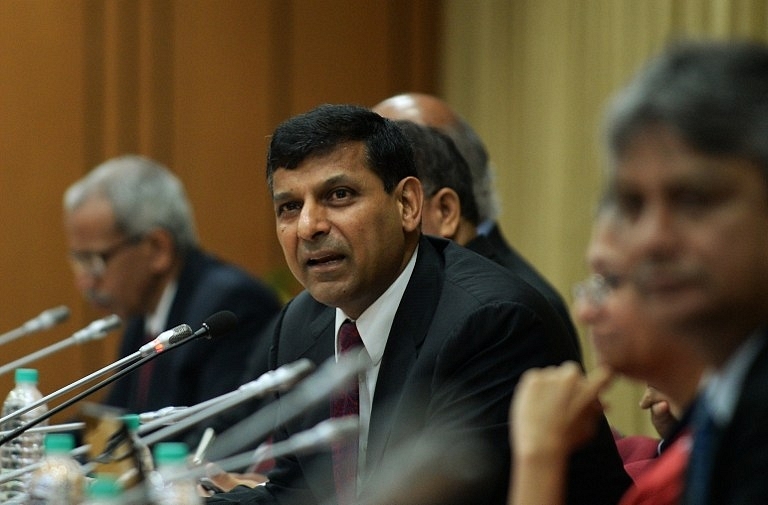Economy
Why Indian Conservatives Must Co-Opt Raghuram Rajan

As the RBI governor, Raghuram Rajan has provided the Indian economy and markets with a measure of stability. Given below, is an appeal to Indian conservatives to ignore quibbles and embrace Rajan wholeheartedly in the larger interest of the Indian economy.
As an analyst following Indian policy debates from a distance, I find the unnecessary friction between the resurgent conservatives and Raghuram Rajan disconcerting. It is all the more perplexing, given that the coming to power of the Modi government has significantly enhanced the strategic orientation of Indian policymakers.
To try and understand this friction, let me first lay out the points of convergence and divergence as perceived by me.
Points of convergence
– Strategic orientation of Indian policymaking
The Modi government has clearly enhanced the strategic orientation and the resultant reform momentum of the Indian policymaking institutions. Any reading of Rajan’s speeches on Indian economy over the last several years (such as those on crony capitalism, financial inclusion, internationalisation of Indian banking system, Indian monetary policy framework, wilful defaulters, developed market monetary policies) will clearly show their very meaty contribution to these policy debates. Further, the underlying instincts are also clearly aligned with the Modi government’s focus on improving governance and modernising the Indian economy.
– Rajan’s contribution to the Indian economy
One only has to go back to the 2013 ‘taper tantrum’ episode to realise the immense contribution Rajan has made to stabilise Indian markets and the economy. His ingenuous introduction of discounted swaps to banks and other measures quickly stabilised the Indian markets then. Of course, the subsequent emergence of the Modi government and the change in international investors’ perception of India have been the key factors in strengthening that positive momentum.
– Rajan’s forceful intervention in international monetary policy debate
Rajan has very successfully articulated the need for an internationally coordinated monetary policy approach. Before his intervention, central banks of developed economies emphasised their domestic mandate and offered sermons on the need for impacted countries to ‘put their house in order.’ While not much progress has been made on the international coordination front and on the selective provision of currency swap lines by central banks in developed economies, his intervention has clearly increased the Fed’s and IMF’s sensitivity to the spillover effects. One hopes that this will stand India in good stead when the next financial crisis occurs.
Potential sources of disagreements
– Conservative monetary policy
As one has come to expect of governments across the world, the Modi government too is calling for a more stimulative monetary policy. While Rajan’s views on the underlying inflationary (or deflationary) impulse in the economy can be finely debated by monetary and other analysts, one cannot deny that he has brought a more professional framework to monetary policymaking. His push towards a formal inflation framework has strengthened India’s policy credibility at the same time as putting it on a trajectory to a lower inflationary environment and consequent low interest rate economy. The larger decline in longer term rates (than the 50bp RBI rate cut) clearly is a reflection of the policy credibility as well as global market environment. Further, it is prudent to follow a conservative policy, bearing in mind the possible fallout from Fed’s policy normalisation (which, however, seems to be eternally postponed).
– Hawkish policy on banking sector challenges
Rajan has been one of our most hawkish central bank governors in terms of tackling the chronic NPL recovery issues as well as in the need for strengthening the capital base of banks in general, and public sector banks, in particular. Clearly, while this pressure is not supportive to the economy currently, it puts in place a sound foundation for medium term growth. And, who can argue against the need for stronger banks to match the growth ambitions of the government. If the banks are stronger and healthier, the monetary policy transmission would also be more effective.
– Make in/for India tussle
It is reasonable to charge Rajan of political naiveté with the way he interceded into the ‘Make in India’ policy platform with his own ‘Make in India, Largely for India’ speech. However, his points on slow growth outlook for developed economies as well as call for entrepreneur-friendly (rather than exporter-focussed) policies are a significant contribution to this critical policy debate.
A look at the significant positive aspect is that his contribution and alignment of reformist zeal with the new government is more important and useful for India in the medium to long term. One hopes that quibbles over timing and pace of policy easing and out-of-turn speeches do not miss this broader perspective.
I end with a plea to the conservatives to more wholeheartedly co-opt Rajan into the establishment. At the same time, I hope that Rajan will continue to play a central role in Indian policy making for years to come.
Support Swarajya's 50 Ground Reports Project & Sponsor A Story
Every general election Swarajya does a 50 ground reports project.
Aimed only at serious readers and those who appreciate the nuances of political undercurrents, the project provides a sense of India's electoral landscape. As you know, these reports are produced after considerable investment of travel, time and effort on the ground.
This time too we've kicked off the project in style and have covered over 30 constituencies already. If you're someone who appreciates such work and have enjoyed our coverage please consider sponsoring a ground report for just Rs 2999 to Rs 19,999 - it goes a long way in helping us produce more quality reportage.
You can also back this project by becoming a subscriber for as little as Rs 999 - so do click on this links and choose a plan that suits you and back us.
Click below to contribute.
Latest